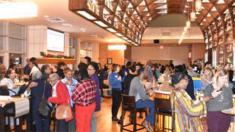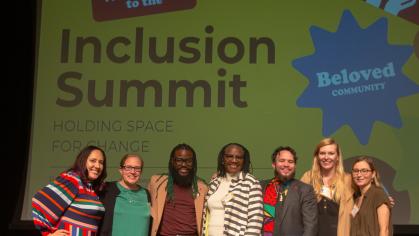Building an Inclusive Community for Faculty and Staff

Faculty and staff of color, in addition to our students and alumni, make up the vibrant fabric of the Rutgers community. But low numbers mean that often they do not see themselves represented in their work environments. This can create a sense of isolation and frustration. The Division of Diversity, Inclusion, and Community Engagement began hosting a Faculty and Staff of Color Reception, last fall, to introduce faculty and staff of diverse backgrounds across the New Brunswick campuses to one another.
“Community doesn’t happen by accident,” Dr. Anna Branch, Senior Vice President for Equity, who oversees the Division said. “The area where we have challenges as an institution is making sure that people feel that they’re part of a greater something, a larger whole, a sense of connectedness.”
At the inaugural reception held in December 2019, nearly 300 faculty and staff of color gathered at the Rutgers Club. Courtney McAnuff, Vice Chancellor of Enrollment Management, who was among the attendees, said he felt a sense of belonging at the reception. It enabled him to connect with other faculty and staff of color, some of which, for the first time.
“The first reception was an amazing experience,” McAnuff shared. “I’ve worked at Rutgers for 14 years, and I actually met more employees of color than I have in the previous 14 years.”
Tiandra Jones, Director of the Student Support Services program, said the reception helped her to put “faces to names,” and meet other faculty and staff she has mostly corresponded with over email.
“I feel connected to other parts of the campus,” Jones said of her time at the reception. “New Brunswick is a large campus, we have Livingston, Busch, Cook Douglass, College Avenue, and so everyone doesn’t have a chance to travel outside of their offices. It’s not that we always want to work in these silos, but we don’t always have the time and space so being in this space, I feel more connected.”
For many attendees like McAnuff and Jones, the Faculty and Staff of Color reception could be considered what sociologist Ray Oldenburg refers to as a “third space.” The intermediate between home (“first space”) and work (“second space”), third spaces are common, neutral places where people come together to exchange ideas, nurture one another, and create relationships. Oftentimes, third spaces do not rely on social status, but instead people in these spaces feel that their social identities are welcomed and encouraged to thrive.
In her column for Inside Higher Ed, “Meeting to Transgress,” KerryAnn O’Meara, professor of higher education at the University of Maryland, suggests that while third spaces are not the ultimate solution to institutional challenges, their presence can be restorative.
“Regardless of the quality of your work or of your mentorship and preparation, you are very likely to experience distinct challenges,” O’Meara writes. “Wouldn’t it be helpful to look across a room, even once a month for two hours, and see others with a common identity? Wouldn’t the resonance and relief of that experience, as well as the conversation and strategies shared among those experiencing similar challenges, add to your agency and well-being?”
For Michael Ajagbe, Senior Mentoring and Education Program Coordinator of the Collaborative Center, O’Meara’s hypothetical scenario becomes even more resonant.
“It feels great being in this space -- to see people who look like you, to be able to engage, to be able to network with one another,” Ajagbe said. “It’s also an opportunity for people to build with one another and share life experiences. It’s such a great atmosphere and it's something that has been missing for quite some time.”
At the second Reception held in March, the Division hosted another 300 participants. During the event, attendees participated in a “Bingo-style” networking game to learn more about each other. Winners received a special prize for their efforts.
Tony Calcado, Executive Vice President and Chief Operating Officer, said spaces like the reception are crucial opportunities for bringing people together.
“There’s nothing more important that we can do at the university than to give everyone a voice and to make sure that we’re respectful of everyone,” Calcado said. “And that we appreciate everyone’s diverse backgrounds, that we look at everyone for what they bring to work every day.”
As a semester tradition, the aims of the Faculty and Staff of Color Reception extend far beyond the physical space itself. “Rutgers is compositionally diverse -- that we’ve accomplished, but it takes work to be inclusive,” Branch said. “It takes work to create a supportive and sustaining community, and the reception is part of the way we do that.”
The Division hosts the Faculty of Color reception once a semester and is exploring a virtual means to host the gathering this fall. Be on the lookout for more information about the reception and join our listserv to learn about other ways to get connected.
# # #

